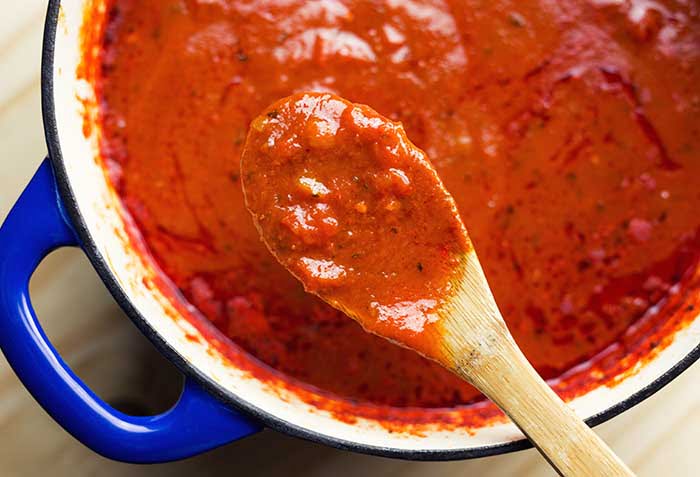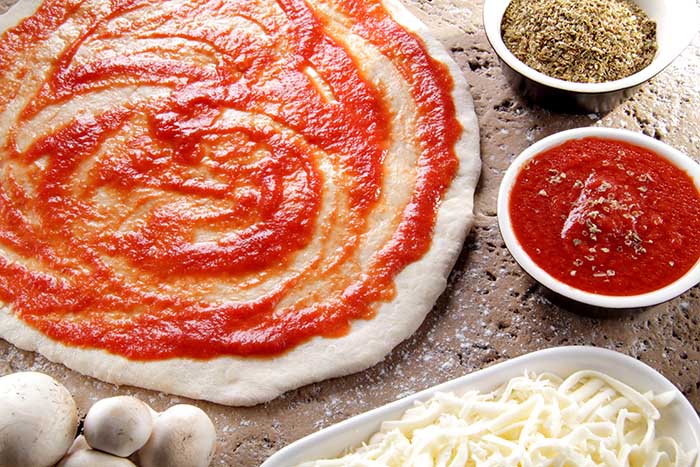Pizza sauce and marinara are two of the most widely-used tomato sauces enjoyed today but, despite what you might think, they’re not the same. Find out the difference between these two delicious sauces and when to use them with our cooking ingredient guide.

So, you love pizza and are looking for a way to take your favorite dish up a notch? You may have heard of Pizza Sauce vs. Marinara and now you want to know what it is all about. Well, this article will answer that question for you while also providing some great recipes!
What is Marinara Sauce?
The story of marinara sauce starts in Italy. Reports say it may have come from Naples or Sicily. This is a tomato-based sauce, thought to be named after sailors. The word marinara is derived from Marinaro, which means sailor. The tale says they often served the sauce to sailors who would come back home.

This is a simple and classic Italian sauce. It was first used in Southern Italy around when tomatoes are said to have first appeared in the area. It’s a sauce made by sauteing garlic and onion in some oil, followed by tomato sauce.
Marinara Sauce Ingredients
This sauce is said to be one of the simplest sauces and has very few ingredients. Namely, garlic, olive oil, onions, and tomatoes. Here are the quantities you will need.
- 2 cups of tomato sauce
- chopped basil leaves
- minced garlic cloves
- 2 tablespoons of olive oil
- salt & pepper (to taste)
You can increase these ingredients for more sauce. If it turns too thin, you can thicken spaghetti sauce by letting it reduce at a simmer for twenty minutes.
What is Pizza Sauce?
Pizza sauce is, as you can imagine, the sauce used for pizza bases. It is very similar to marinara sauce and is often interchanged, but there is a difference. The ingredients used in pizza sauce are similar to those used in marinara sauce. Pizza sauce is spread on the pizza base. It’s what holds the ingredients together and gives it the tangy-sweet taste from the tomato paste.

Pizza Sauce Ingredients
To make pizza sauce, you can use the same ingredients as those you use to make marinara sauce. Or you could switch it up a bit. For this sauce, canned tomatoes with no spice work best. This is because fresh tomatoes usually have a lot of water, which doesn’t work well with pizza. Just remember that the tomatoes that you choose will influence the taste of the sauce. Here’s a more detailed list of the ingredients that you will need.
- Crushed tomatoes as well as whole peeled tomatoes
- Parmesan cheese
- White granulated sugar
- Ground black pepper
- Italian Seasoning Fennel Seeds
- Oregano
- Fresh basil leaves
- Minced onion
- Fresh garlic cloves
- Extra virgin olive oil
What are the differences between Pizza & Marinara Sauce?
One of the major differences between the two sauces is that pizza sauce is not pre-cooked like marinara sauce is. Pizza sauce is blended and later cooked when put on the pizza. It instead depends on the cooking process and other ingredients added to the pizza to amp up the flavor and bring out the best. The marinara sauce has more flavor and a fuller taste. It’s the complete package and doesn’t need to be cooked first, which means you can use it as it is. For instance, it can be used as a dip.
Now let’s look at the difference in inconsistency. Pizza sauce is not as thick as a marinara sauce when it is made right. Also, pizza sauce is made explicitly for pizza, while You can use the marinara sauce in various recipes. Also, the other difference is that marinara sauce is made using tomato sauce while pizza sauce is a type of tomato sauce.
Can I Use Marinara Sauce for Pizza?
Yes, the two can be interchanged. The marinara sauce has already been cooked, and as such, it means that when you use marinara in place of pizza sauce, the taste will differ slightly. Some of the sweetness will be lost in the process when making marinara, but the flavors are fuller. Pizza sauce still has the tomato’s sweetness coming through strongly.
The great thing about the marinara sauce is that it’s an Italian classic and, as such, will work well with various traditional Italian dishes such as pizza.

What Can I Substitute for Pizza Sauce?
Pasta Sauces
Sometimes, you don’t always have the right ingredients to make your pizza sauce. In most cases, tomato sauce is often the most common choice, but it’s not the only choice. For example, you can choose to go with traditional pasta sauces, which will usually have similar base ingredients such as tomato, garlic, onion, and olive oil.
One such sauce is Arrabiata. It is spicy and, as such, has a bit of kick to it. Consider this when pairing it with your pizza and the intended toppings. A similar sauce is siciliana, which is made of red plum and tomatoes. Again, you can describe it as having a spicy and earthy taste. Another sauce they also make that can be used in place of pizza sauce is puttanesca. It has a bold flavor that comes through and stands well on its own. Arrabiata is also on the spicy and robust side.
Red Pesto
The other substitute that you could use is red pesto. It has a sun-dried tomato base, which gives it its distinct taste. The tomatoes are then flavored with cheese and herbs such as basil. The flavor is characteristically tangy and adds a different dimension to pizza. Again, you can either make your own or buy pesto in the store.
To store pesto properly, you will need to make sure it is kept in an airtight container. When this is done, you can keep it for up to three days. If you freeze it, you can keep it for three months. To make your pesto, blend all the ingredients until they form a smooth paste.
Bechamel
Pizza sauce doesn’t always need to be tomato-based. You can also make a white roux using flour, butter, milk, and the seasonings of your choice. This is great, especially if you don’t particularly like tomatoes or can’t eat them.
To make this sauce, you will need three tablespoons of unsalted butter, 1/4 cup finely chopped onion, 1/4 cup all-purpose flour, 1/2 teaspoon coarse salt, 4 cups whole milk. Melt the butter in a pan, then cook the onion. Add the flour and seasoning, then cook for about 5 minutes. Whisk in the milk and cook for a further 7 minutes. You want it to feel smooth.



